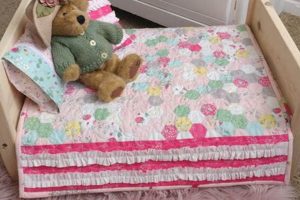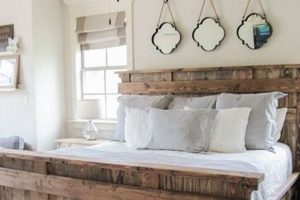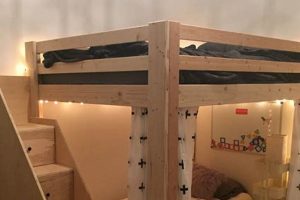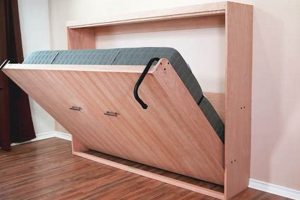A self-constructed elevated planting structure integrated with a supporting framework, commonly of latticework, defines a particular type of gardening system. This system combines the advantages of container gardening with vertical growing techniques. It is often employed to cultivate plants that benefit from climbing support, such as vining vegetables, flowering creepers, or fruiting shrubs. As an example, individuals might build such a structure to grow tomatoes or cucumbers vertically in a limited space.
These structures offer multiple benefits. They provide improved drainage, reduce soil compaction, and minimize bending and kneeling, which enhances accessibility for gardeners with physical limitations. Furthermore, the vertical trellis element promotes air circulation, reducing the risk of fungal diseases. Historically, similar structures have been employed to maximize yields in small gardens, dating back to early agricultural practices.
The following sections will detail the process of planning, constructing, and maintaining such a structure, focusing on material selection, structural integrity, and optimal plant selection for enhanced growth and productivity. Detailed information on design considerations and effective construction techniques will be provided.
Essential Construction and Utilization Guidelines
The construction and utilization of such a structure demand careful planning and execution to ensure structural integrity and optimal plant growth. The following guidelines provide critical insights for successful implementation.
Tip 1: Material Selection is Paramount: Opt for weather-resistant materials such as cedar, redwood, or treated lumber to withstand environmental exposure. Avoid using pressure-treated wood manufactured before 2003, as it may contain arsenic.
Tip 2: Foundation Stability is Critical: Ensure a level and stable foundation. Consider using landscape fabric beneath the bed to prevent weed growth and maintain soil quality.
Tip 3: Trellis Design Should Match Plant Needs: Design the trellis with appropriate spacing and material strength to support the specific plants being cultivated. For heavier vines, a sturdier trellis using thicker lumber is recommended.
Tip 4: Drainage is Essential: Incorporate drainage holes or a gravel layer at the bottom of the bed to prevent waterlogging and root rot. Excess moisture can severely impact plant health.
Tip 5: Soil Composition Matters: Use a well-draining soil mix rich in organic matter to promote healthy root development and nutrient uptake. Amend the soil as needed based on the specific needs of the plants being grown.
Tip 6: Proper Plant Placement is Key: Consider the mature size and growth habit of plants when determining spacing. Overcrowding can restrict airflow and increase the risk of disease.
Tip 7: Regular Maintenance is Necessary: Inspect the structure regularly for signs of wear, damage, or insect infestation. Address any issues promptly to prevent further deterioration.
Adherence to these guidelines will contribute significantly to the longevity and productivity of the structure, resulting in a thriving garden and abundant harvests.
The subsequent section will address advanced techniques for optimizing plant yields and managing potential challenges in this gardening approach.
1. Planning
Effective planning is paramount to the successful creation of a self-constructed elevated garden bed with an integrated trellis. This phase establishes the framework for all subsequent actions, ensuring that the finished structure meets both aesthetic and functional requirements. Without thorough forethought, potential issues related to structural integrity, plant compatibility, and resource allocation may arise.
- Site Assessment and Space Optimization
The initial step involves a comprehensive assessment of the chosen site. Considerations include sunlight exposure, soil conditions (if the bed is in contact with the ground), and available space. Optimizing space involves accurately measuring dimensions and determining the most efficient layout to maximize growing area while allowing for accessibility and maintenance. Failure to adequately assess the site may result in suboptimal plant growth or structural inefficiencies.
- Structural Design and Material Selection
Planning necessitates a detailed structural design that considers the load-bearing capacity of the bed and trellis. The design should specify dimensions, joint types, and reinforcement strategies to ensure stability. Material selection is intrinsically linked to the design, requiring careful consideration of factors such as weather resistance, durability, and cost. Choosing inappropriate materials can compromise the structure’s longevity and safety.
- Plant Compatibility and Growth Requirements
A well-planned garden considers the specific needs of the intended plants. Factors such as sunlight requirements, soil pH, and vertical growth habits must be considered to ensure compatibility within the limited space of the raised bed. Selecting incompatible plants may lead to stunted growth, competition for resources, or increased susceptibility to disease. The integration of the trellis must be designed to accommodate the specific climbing or vining habits of the chosen plants.
- Resource Allocation and Budgeting
Comprehensive planning includes meticulous resource allocation, encompassing materials, tools, and labor. A detailed budget should be established to prevent cost overruns and ensure that necessary resources are available throughout the construction process. Proper budgeting helps prioritize expenditures and avoid compromising on material quality or structural integrity due to financial constraints.
These facets of planning are interdependent and contribute directly to the ultimate success of the raised garden bed and trellis. Neglecting any one aspect can lead to structural deficiencies, plant health issues, or financial setbacks. Through careful and comprehensive planning, the likelihood of achieving a thriving and sustainable garden is significantly increased.
2. Materials
The selection of appropriate materials directly dictates the longevity, structural integrity, and suitability of a self-constructed elevated garden bed with an integrated trellis. Material choice influences resistance to environmental degradation, load-bearing capacity to support soil and plants, and the potential for leaching harmful substances into the growing medium. For instance, untreated lumber, while cost-effective, is susceptible to rot and insect infestation, necessitating frequent replacement. Conversely, pressure-treated lumber, particularly older formulations, may contain chemicals potentially detrimental to plant health and soil composition.
Considerations extend beyond the primary structural components. Fasteners, such as screws and nails, must be corrosion-resistant to prevent structural weakening over time. Trellis materials, whether wood, metal, or plastic, must withstand wind load and plant weight without buckling or breaking. Soil composition itself can exert significant pressure on the bed’s walls, necessitating robust construction materials. The cost-benefit analysis of various materials requires careful evaluation of initial investment versus long-term durability and maintenance requirements. Concrete blocks, for example, offer superior longevity but present a higher initial cost and greater construction complexity compared to wooden alternatives.
In summary, the relationship between material selection and the overall functionality of a self-constructed elevated garden bed with a trellis is fundamental. Informed choices, considering both immediate needs and long-term performance, are critical for creating a sustainable and productive gardening system. Overlooking this vital connection can lead to premature failure, compromised plant health, and increased maintenance demands, thereby undermining the intended benefits of the structure.
3. Construction
The construction phase is pivotal in realizing a functional and enduring elevated garden bed with an integrated trellis. This stage transforms conceptual designs and selected materials into a tangible and operational horticultural structure. Effective construction necessitates adherence to sound engineering principles and precise execution, impacting both structural integrity and aesthetic appeal.
- Foundation Preparation and Bed Assembly
The initial construction activity involves preparing a stable and level foundation. This may include excavating a shallow trench, laying down landscape fabric, or constructing a gravel base to enhance drainage and prevent weed growth. Bed assembly follows, involving the secure joining of pre-cut lumber or other chosen materials. Proper alignment and secure fastening are crucial to prevent warping or collapse under the weight of soil and plants. Errors in foundation preparation or bed assembly can compromise the overall structural integrity and lead to premature failure.
- Trellis Integration and Support Mechanisms
The integration of the trellis system requires careful consideration of the chosen materials and design. Secure attachment to the raised bed is essential to withstand wind loads and the weight of mature plants. Support mechanisms, such as cross-bracing or ground anchors, may be necessary to enhance stability, particularly for taller or heavier trellis structures. Improper trellis integration can result in collapse or damage to the raised bed, potentially harming plants and creating a safety hazard.
- Drainage Implementation and Soil Containment
Effective drainage is critical to prevent waterlogging and root rot. This is typically achieved by incorporating drainage holes or a layer of gravel at the bottom of the bed. Soil containment involves ensuring that the bed’s walls are adequately sealed to prevent soil erosion or leakage. Liner materials, such as heavy-duty plastic or landscape fabric, may be used to protect the wood from moisture and prolong its lifespan. Inadequate drainage or soil containment can lead to plant health issues and necessitate costly repairs.
- Finishing Touches and Protective Measures
The final construction phase involves applying finishing touches, such as sanding rough edges, applying a protective sealant, or adding decorative elements. These measures enhance the aesthetic appeal and prolong the lifespan of the structure. Sealants should be non-toxic and safe for use in garden environments. Failure to apply protective measures can result in accelerated deterioration due to weathering and pest infestations.
In summation, the construction phase is a critical determinant of the success of an elevated garden bed with an integrated trellis. Meticulous attention to detail, adherence to sound engineering principles, and the application of protective measures are essential for creating a durable, functional, and aesthetically pleasing horticultural structure. Neglecting any of these aspects can compromise the long-term viability and productivity of the garden.
4. Plant Selection
Plant selection represents a critical determinant of success in the context of a self-constructed elevated garden bed integrated with a trellis. The suitability of chosen species directly impacts both the aesthetic appeal and productive capacity of the gardening system. Incompatible plant choices can lead to diminished yields, structural strain, or even complete failure of the gardening endeavor.
- Growth Habit and Trellis Compatibility
Plant selection necessitates careful consideration of growth habits. Vining plants, such as cucumbers or pole beans, are naturally suited to trellis systems, utilizing the vertical support for optimal sunlight exposure and air circulation. Bush-type plants, conversely, require alternative support structures or are unsuitable for trellis integration. Selecting plants with incompatible growth habits can result in inefficient space utilization, structural damage, or reduced plant health. For example, attempting to train a heavy, sprawling squash variety on a lightweight trellis may lead to collapse.
- Sunlight Requirements and Microclimate Considerations
Different plant species exhibit varying sunlight requirements. Raised beds offer the advantage of controlled soil composition and improved drainage, but they also create localized microclimates. Trellises can cast shadows, altering the light exposure for plants in their vicinity. Selecting plants that thrive in the available sunlight conditions is crucial. Planting shade-tolerant species in areas with full sun exposure, or vice versa, can lead to stunted growth or leaf scorch. Careful planning of plant placement in relation to sunlight and trellis orientation is therefore essential.
- Nutrient Needs and Soil Management
Plant selection should align with the nutrient availability within the raised bed. Different plant species have varying nutrient requirements, and soil composition must be adjusted accordingly. Legumes, for example, fix nitrogen in the soil, potentially benefiting neighboring plants. Conversely, heavy feeders, such as tomatoes, may deplete nutrients rapidly, requiring supplemental fertilization. Choosing plants with complementary nutrient needs can optimize resource utilization and reduce the need for external inputs. Overcrowding can exacerbate nutrient deficiencies and increase competition for resources.
- Mature Size and Spatial Constraints
Plant selection must take into account the mature size of chosen species relative to the spatial constraints of the raised bed and trellis. Overcrowding can restrict airflow, increase the risk of disease, and limit access for maintenance. Vigorous growers, if not properly managed, can quickly overwhelm the available space, shading out neighboring plants and compromising overall productivity. Careful consideration of mature size allows for efficient space utilization and reduces the need for aggressive pruning or thinning.
The interplay between plant selection and the structural and environmental characteristics of a self-constructed elevated garden bed with a trellis is undeniable. Thoughtful plant selection, informed by an understanding of growth habits, sunlight requirements, nutrient needs, and spatial constraints, is paramount for creating a thriving and productive garden ecosystem. Disregarding these factors can result in suboptimal plant performance, structural instability, or increased maintenance demands, ultimately undermining the intended benefits of this integrated gardening approach.
5. Maintenance
Sustained productivity and longevity of a self-constructed elevated garden bed with an integrated trellis hinge significantly on consistent and appropriate maintenance practices. Neglecting this aspect precipitates structural degradation, compromised plant health, and diminished yields. Regular attention to maintenance protocols is thus paramount for realizing the full potential of this gardening system.
- Structural Inspection and Repair
Regular inspection of the structural components, including the bed walls, trellis supports, and fastening hardware, is critical. Wooden elements are susceptible to rot, insect infestation, and weathering, while metal components may corrode. Cracks, loose joints, or signs of decay necessitate prompt repair or replacement. Failing to address these issues can lead to structural instability, posing a hazard to plants and potentially requiring costly reconstruction. Applying protective sealants and preservatives can extend the lifespan of wooden components.
- Soil Management and Nutrient Replenishment
The soil within a raised garden bed is a finite resource that requires periodic replenishment. Over time, nutrients are depleted by plant uptake and leaching. Regular soil testing provides insights into nutrient levels and pH, enabling targeted amendments. Incorporating compost, aged manure, or other organic matter replenishes nutrients, improves soil structure, and enhances water retention. Neglecting soil management results in nutrient deficiencies, stunted plant growth, and reduced yields. Proper soil pH is also critical for nutrient availability.
- Pest and Disease Control
Elevated garden beds, while offering some protection, are not immune to pests and diseases. Regular monitoring for signs of infestation or infection is essential. Early detection allows for timely intervention using appropriate control measures. Integrated pest management (IPM) strategies, which prioritize non-chemical methods, are recommended to minimize environmental impact and protect beneficial insects. Removing diseased foliage and maintaining good air circulation can help prevent the spread of pathogens. Ignoring pest and disease issues can lead to significant crop losses and plant death.
- Trellis Management and Plant Support
As plants grow and mature, they require ongoing support from the trellis system. Regularly pruning and training vines ensures that they are evenly distributed and adequately supported. Securing plant stems to the trellis with appropriate ties prevents breakage and promotes optimal growth. Overgrown or unruly plants can place undue stress on the trellis structure, potentially leading to collapse. Regular inspection and adjustment of plant support systems are crucial for maintaining both plant health and structural integrity.
The maintenance protocols outlined above, when implemented consistently, collectively contribute to the sustained health, productivity, and aesthetic appeal of a self-constructed elevated garden bed with an integrated trellis. Adherence to these practices mitigates the risk of structural failure, promotes optimal plant growth, and maximizes the return on investment in this gardening system. Conversely, neglecting maintenance can lead to a cascade of negative consequences, ultimately undermining the benefits of raised bed gardening and requiring extensive remediation efforts.
6. Drainage
Effective drainage is an indispensable component of a self-constructed elevated garden bed integrated with a trellis. The absence of adequate drainage mechanisms initiates a cascade of detrimental effects on plant health and the structural integrity of the bed itself. Waterlogged soil restricts oxygen availability to plant roots, leading to root rot, a condition that inhibits nutrient uptake and ultimately compromises plant viability. Furthermore, prolonged exposure to excess moisture accelerates the decomposition of wooden bed components, reducing their lifespan and requiring premature replacement. Conversely, well-drained soil facilitates robust root development, enhances nutrient absorption, and minimizes the risk of fungal diseases. For instance, a tomato plant grown in a raised bed with insufficient drainage will exhibit stunted growth, yellowing leaves, and increased susceptibility to blossom end rot, whereas the same plant in a well-drained bed will thrive, producing abundant and healthy fruit.
The implementation of effective drainage strategies in these structures involves several practical considerations. The incorporation of drainage holes in the base of the bed, typically spaced at regular intervals, allows excess water to escape freely. A layer of gravel or coarse sand at the bottom of the bed further enhances drainage by preventing soil compaction and promoting water flow. The composition of the soil mix itself plays a critical role; a well-draining mix typically incorporates perlite, vermiculite, or coarse sand to improve aeration and reduce water retention. The selection of appropriate liner materials, if used, must also consider drainage properties, ensuring that water can escape while preventing soil erosion. For instance, a raised bed lined with impermeable plastic without drainage holes will effectively become a container, trapping excess water and creating an anaerobic environment detrimental to root health.
In conclusion, the provision of adequate drainage is not merely an ancillary detail but a fundamental design requirement for a successful self-constructed elevated garden bed with a trellis. Failure to prioritize drainage considerations leads to a predictable sequence of negative outcomes, including plant disease, structural deterioration, and ultimately, the failure of the gardening system. Conversely, the implementation of appropriate drainage strategies promotes a healthy root environment, extends the lifespan of the structure, and maximizes the productive potential of the garden. The understanding and application of these principles are essential for any individual undertaking the construction and maintenance of such a gardening system.
7. Support
In the context of a self-constructed elevated garden bed integrated with a trellis, ‘support’ encompasses both the physical structures and the operational practices that enable optimal plant growth and overall system stability. This element is crucial for maximizing the benefits of such a gardening setup, influencing everything from plant health and yield to the longevity of the structure itself.
- Structural Integrity of the Trellis
The trellis component provides direct physical support to climbing and vining plants. Its construction must withstand the combined weight of mature plants, wind loads, and environmental stressors. Inadequate structural integrity can lead to trellis collapse, damaging plants and potentially compromising the raised bed structure. Material selection, joint construction, and anchoring methods are key factors influencing trellis stability. For instance, using lightweight lumber for a trellis intended to support heavy squash vines is a common error leading to failure.
- Vertical Growth Management
Support extends beyond the physical structure to include practices that guide and manage plant growth. Pruning, training, and tying plants to the trellis ensure even distribution of weight and optimal exposure to sunlight and air circulation. Neglecting these practices can result in overcrowding, increased susceptibility to disease, and reduced yields. For example, allowing a dense canopy of leaves to develop on a climbing bean plant can restrict sunlight to lower leaves, reducing productivity and promoting fungal growth.
- Soil Stability and Root Support
The raised bed itself must provide adequate support for plant roots. A well-draining soil mix allows for healthy root development, enabling plants to anchor themselves and efficiently absorb nutrients. Soil compaction, however, restricts root growth and reduces plant stability. Soil amendments, such as compost or peat moss, can improve soil structure and provide enhanced root support. Inadequate soil support can lead to stunted growth and increased susceptibility to wind damage.
- Environmental Protection and Climatic Buffering
Support can also refer to measures that protect plants from environmental extremes. Windbreaks, shade cloths, or row covers can be used in conjunction with the raised bed and trellis to mitigate the effects of strong winds, intense sunlight, or frost. These protective measures enhance plant survival and promote consistent growth. For example, a lightweight fabric draped over the trellis can protect delicate seedlings from late spring frosts, extending the growing season and increasing overall yields.
These facets of support are interconnected and essential for the successful operation of a do-it-yourself elevated garden bed with a trellis. By providing adequate structural support, managing plant growth, ensuring soil stability, and mitigating environmental stresses, gardeners can maximize the productivity and longevity of their gardening system. Overlooking any of these aspects can lead to reduced yields, structural damage, or increased maintenance demands, ultimately undermining the benefits of this integrated gardening approach.
Frequently Asked Questions
The following addresses common inquiries concerning the planning, construction, and maintenance of self-constructed elevated garden beds featuring integrated trellis systems.
Question 1: What is the minimum recommended depth for a raised garden bed intended for growing root vegetables?
The minimum recommended depth for a raised garden bed intended for root vegetables is generally 12 inches (30 centimeters). Shallower depths may restrict root development and reduce yields.
Question 2: Which wood types are most resistant to rot and decay in a raised garden bed environment?
Cedar and redwood exhibit natural resistance to rot and decay, making them suitable choices for raised garden bed construction. Pressure-treated lumber provides enhanced protection, but its suitability for organic gardening should be carefully considered.
Question 3: How should a trellis be anchored to a raised garden bed to ensure structural stability?
A trellis can be anchored to a raised garden bed using sturdy brackets, bolts, or screws. The anchoring method should be appropriate for the materials used in both the bed and the trellis. Deep anchoring into the ground surrounding the bed may also enhance stability.
Question 4: What soil amendments are recommended for improving drainage in a raised garden bed?
Perlite, vermiculite, and coarse sand are commonly used soil amendments to improve drainage in a raised garden bed. The specific amendment and quantity should be determined based on the existing soil composition and the needs of the plants being grown.
Question 5: How frequently should a raised garden bed be watered, and what factors influence watering frequency?
Watering frequency depends on various factors, including plant type, soil composition, weather conditions, and drainage efficiency. Consistent monitoring of soil moisture levels is recommended to determine appropriate watering intervals. Overwatering should be avoided.
Question 6: What are the most common pests and diseases affecting plants grown in elevated garden beds, and how can they be managed effectively?
Common pests and diseases include aphids, spider mites, fungal infections, and root rot. Integrated pest management (IPM) strategies, including biological controls, cultural practices, and targeted applications of approved pesticides, are recommended for effective management.
Key takeaways include the importance of proper soil depth for root vegetables, the selection of rot-resistant wood, secure trellis anchoring, effective drainage management, and consistent monitoring for pests and diseases.
The next section will provide detailed guidance on selecting appropriate plant species for integration within an elevated garden bed and trellis system.
DIY Raised Garden Bed with Trellis
The preceding exploration has underscored the multifaceted considerations inherent in the construction and utilization of a diy raised garden bed with trellis. From meticulous material selection and structurally sound construction to strategic plant selection, effective drainage management, and diligent maintenance, each element contributes to the system’s overall success. A failure to adequately address any of these facets jeopardizes the structure’s longevity, plant health, and productive capacity.
The diy raised garden bed with trellis represents not merely a gardening structure, but an integrated ecosystem demanding informed decision-making and consistent stewardship. Its successful implementation requires a commitment to understanding the interconnectedness of its components. The benefits derived from this approach enhanced accessibility, improved soil control, and maximized vertical space are contingent upon a rigorous application of the principles outlined herein. The diligent gardener, equipped with this knowledge, can cultivate a sustainable and bountiful environment.







